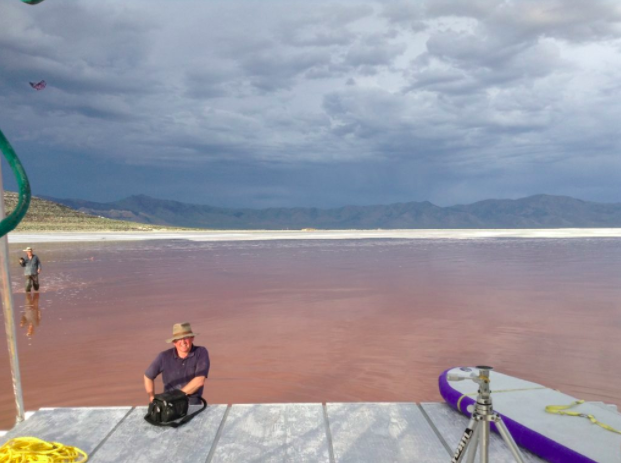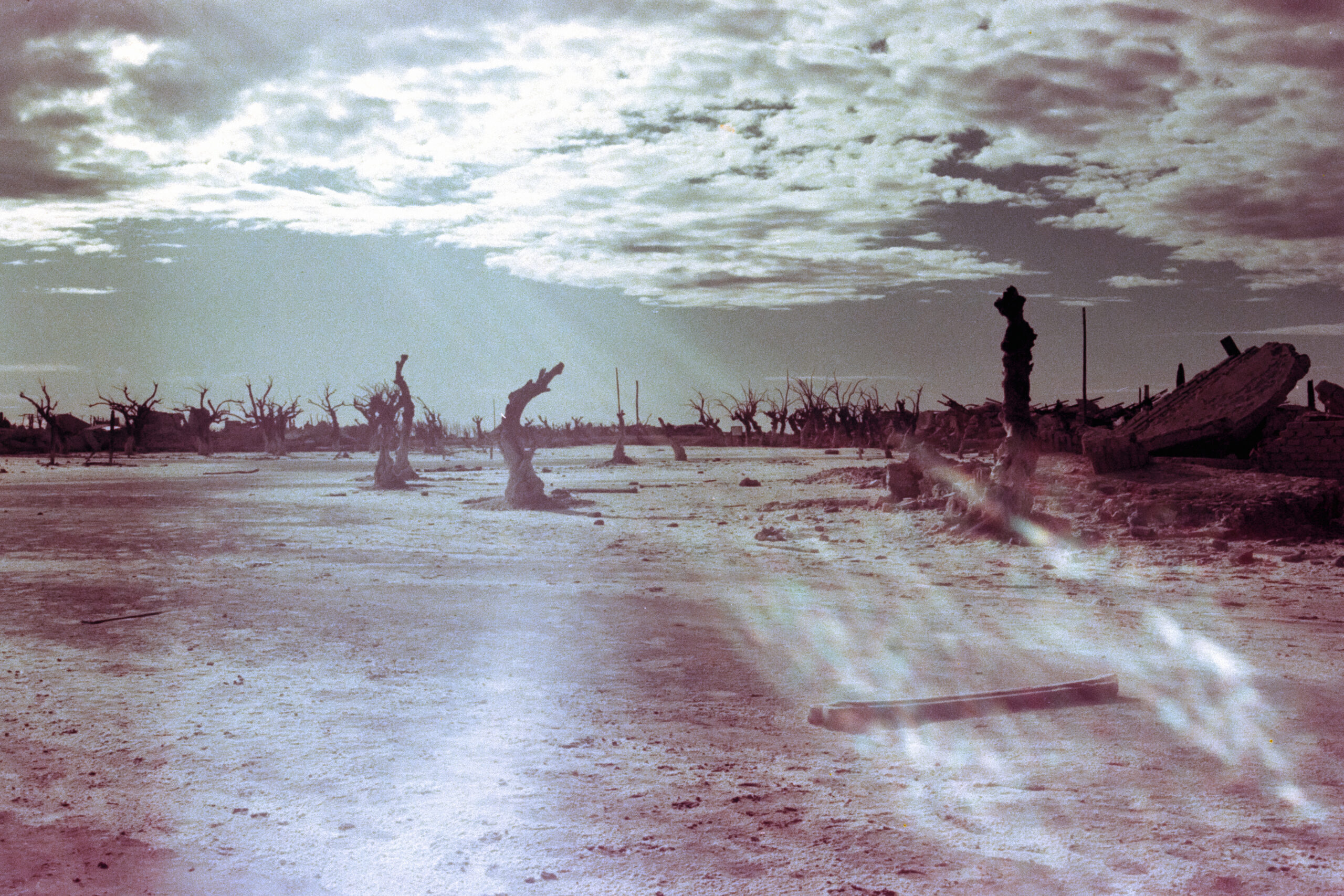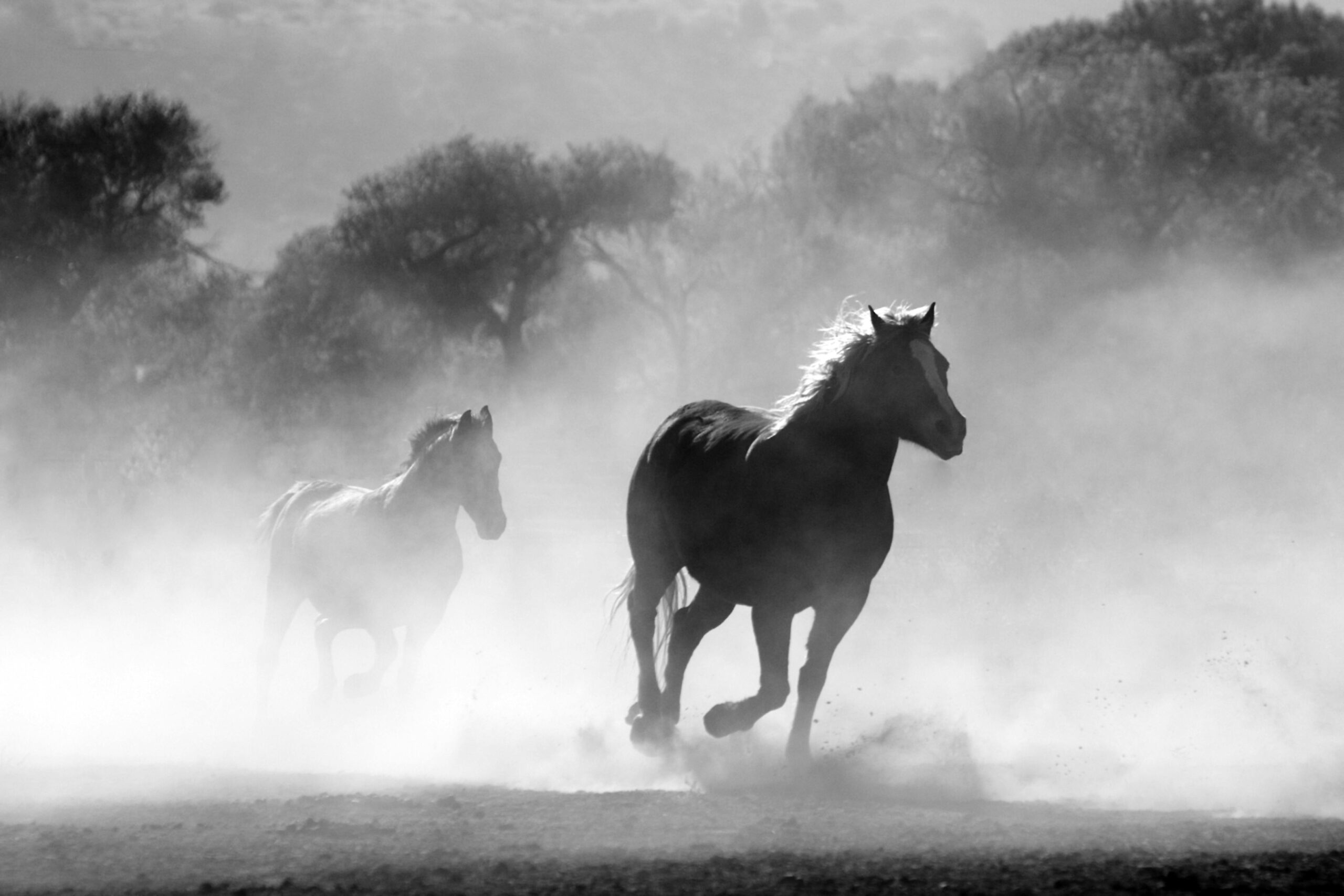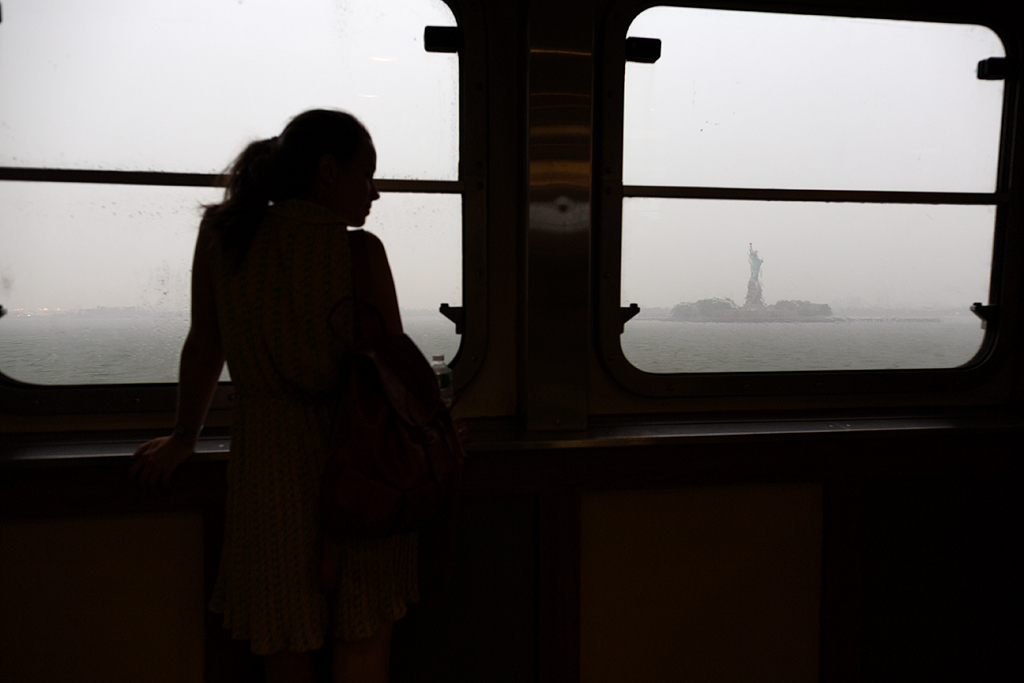We are barreling north out of Salt Lake City, and David is talking about the clouds. “They don’t look like the clouds in the East,” he says. “They’re uniform, but fuzzy.” Out the window, the topaz sky shimmers over the mountains. The snowy peaks echo the color of the fuzzy western clouds, which stretch across the air like floating bedsheets.
Chris’s scribbled directions say, “If you see a crashing turn down to the shore where we have set up camp, you’ve gone too far. Turn back and look for the mellower turn.”
Still, we miss the mellower turn. David spots the tents and cars down below as we bounce along the high road. Backtracking, I try to feel like we’re not wasting time, but rather overlaying spent minutes with new ones, creating a textured palimpsest. Our presence here is the lightest pencil trace on top of a fathomless layered history: Mormon pioneers, Spanish priests, French fur traders. The Shoshone, the Anasazi, Paleolithic mammoth hunters. The mammoths themselves. The dinosaurs.
Camp lies on the edge of the lake bed. It’s six in the evening and no one’s around, just a handful of cars and a few neat tents like small UFOs. Labeled coolers, a shade tarp, a fire ring. The sun burns, a patch of white, behind lowering clouds. Silence. There’s no highway noise, no birdsong, no lapping waves, no sound of wind in trees (no trees). Indeed, though we thought we understood that we would be camping at the lakeshore, there isn’t even any lake here that we can see. Instead, before us, a vast expanse of brownish mud stretches into the distance, dotted with puddles left over from last week’s rain, smoke-gray cloud reflections drifting across their surfaces. Odd bits of rusted metal litter the exposed flats. The delicate skeletons and bleached beaks of birds give themselves slowly to the mud.
It was early morning when we left suburban Philadelphia (voluptuous explosions of dew-damp peonies, bees buzzing in the bottlebrush bushes) to travel to this arid landscape where some friends are camping. This is the site of Spiral Jetty, Robert Smithson’s iconic work of land art, built in 1970 out of 1,500 feet of black basalt and earth—six thousand tons! In photographs it looks like a colossal corkscrewing landing strip for a dizzy spaceship. Far from anywhere, often visible only as a shadow under lapping water, the piece has become a kind of art pilgrimage site. Chris brings his students here every year.
On this May weekend, several pursuits are converging. The main lure is that Chris and his collaborator Steve have been building something amazing: a floating laboratory. This solar-powered, pontooned, aluminum launch—called the GSLEP (the Great Salt Lake Exploration Platform)—will be available to people who want to research the local landscape (lakescape), which up till now has been peculiarly unexplored. But perhaps this is not so odd. This part of the Great Salt Lake is so inhospitable that not even fish can live in it. Only tiny brine shrimp, some algae, and a salt-loving microbe called archaea, which, in its millions, shades the water pink. This weekend is the GSLEP’s field test, a chance to check that the craft is seaworthy (lakeworthy) and that the systems work.
Researching the landscape. David and I have been talking over what this means. Research is David’s business—he’s an astronomer—but out here at the lake, the term, like so many things, seems bigger, stranger, and tinged with a different hue, comprehending any kind of penetrating exploration by a creative, not necessarily scientifically trained mind. It is in this spirit that Chris’s partner Ingrid, a contemporary art curator, talks about her university-based museum as a research institute.
I used to work at that museum too, but I quit last summer. I miss Ingrid, whose presence here is a lot of why I made the trip. I have watched her make exhibitions—of gouache illustrations and folded tablecloths; of voices speaking in the near-dark; of sprawling sculptures assembled from forests of wooden poles, electric trains, stacks of dictionaries, and puffs of smoke. I have trailed her through galleries and followed her pointing finger—“Look at that pink!” —and edited her electric, impeccably researched essays. Now that I spend my days alone in a room with a spiral notebook, floundering around inside the arid landscape of the book I’m trying to write, I’m thirsty for her clear-eyed, joyful way of seeing past the obvious to what’s behind it. The cloudy crystal I would have missed, half-buried in the mud, glittering.
There will be eight of us here altogether this weekend. Chris, Ingrid, and Chris’s collaborator Steve. Steve’s wife, Deborah, a filmmaker, whose work often explores landscapes. Matt, the founder of a nonprofit called the Center for Land Use Interpretation (CLUI), which has a branch just across the lake, in Wendover. Marie, an artist who uses tides and currents to propel boats she makes by hand, ferrying passengers through rivers, harbors, and estuaries. David and me. We are the last arrivals, late because we wanted to see our youngest daughter off to prom, to take the hundred requisite photographs of her bright face and long sparkling gown among the rosebushes. We are the only ones on this trip with children. In my mind, the unalloyed lives of the others are great smooth marble eggs they are always polishing, while we live in the ooze between one world and another, trying not to get sucked down.
The other reason we’re here is that it’s my birthday. I’m fifty. Serendipitously, it’s Chris’s fiftieth birthday too. The trip is meant to mark this slippage across the fulcrum. Time may not actually stop here, let alone run backwards as some believe Spiral Jetty’s counterclockwise gyration promises. But perhaps this place will offer a vantage from which to consider time: its gifts and its relentlessness. The way leaves, for instance, are forever budding, unfurling, quivering in sunlight; then browning, parching, and falling away to dust.
By leaves, of course, I mean people.
On a folding table in the middle of camp, amid long chunks of crystalized salt and bottles of bug spray, David spies a note anchored by a walkie-talkie: “We are out on the lake on the GSLEP. Call when you arrive!” We peer across the flats. At the horizon the sky is blue, orange, and aqueous green. The light shifts, and we make out an edge where dark mud gives way to something white. The lake! A tiny shape, which we take to be the GSLEP, moves slowly across the surface. We press some buttons on the walkie-talkie, and soon Ingrid’s voice wheezes tinnily through like Neil Armstrong squawking from the moon: “Walk out as far as you can,” she tells us. “We’ll pick you up.”
Pick us up?
We exchange our sneakers for the mud boots we ordered overnight from Amazon after an urgent text from Chris (there was a lot of unexpected rain), then we walk straight out across a plain crazed with fissures and treacherous with sucking holes. This is the meandering zone, the liminal place between the traditional shoreline and the actual water of the lake, which is many feet lower now than it was in Smithson’s day. Alongside us, a great dilapidated jetty pushes out toward the distant water. This is not Smithson’s spiral one, but rather an abandoned oil exploration protuberance, an artifact of the long wrangle between man and nature that drew the artist to this corner of the Great Salt Lake in the first place. Nothing pumpable was ever found here, but patches of oily tar glisten in the mud. A few raindrops spatter down. Suddenly the sky lightens, and we are picking our way across a hard white field of gleaming salt. Square crystals sparkle in the cloudy light. I run my hand along the diamond-bright crust, put my finger to my mouth and taste it. Smithson wrote: Chemically speaking, our blood is analogous in composition to the primordial seas. Following the spiral steps we return to our origins, back to some pulpy protoplasm, a floating eye adrift in an antediluvian ocean. I am tasting the past, I tell myself. Faint brine, a subtle, pungent sharpness maybe. Nothing much.
At the far edge of the salt field, the water finally begins. Shallow, rippled, Silly Putty pink, it unfurls silently toward the sky which rises from the horizon in a great wash of liquid blue like a stage backdrop. On the surface of the water, the GSLEP floats like a bright metal toy: a silvery platform set on bulging pontoons. Between us and it, a surreal vision: a tall man in a wide-brimmed hat, smiling broadly, pulls a wooden cart through the pink lake.
Architect, teacher, lover of mezcal and adventure, Chris directs the Land Arts of the American West program at Texas Tech, in which students spend two months out in the field, exploring art, the landscape, dams, trash, telescopes, weather. “Climb into the rickshaw!” he tells us, nodding to the cart, and ferries us easily through the blushing waters.
“You made it,” Ingrid cries as we scramble aboard. She introduces us to the others, then proffers pretzels, just as she used to do in her office at the museum when I’d come around late in the afternoon. But that cubicled, collegial, commuter-train-riding existence was another life. Or perhaps a dream. More likely this is the dream: this vast rippling pinkness. This improvised floating world onto which, like backyard robins blown in by a rogue storm, we have improbably alighted.

The Great Salt Lake Exploration Platform: I have been hearing about this project for years. It’s been a decade since Chris, Steve, and another friend drove out to the old bombing range near Wendover, Utah, which is where the crew of the Enola Gay trained to drop the first atomic bomb. Intrigued by local canals dug for industrial salt evaporation, the three men hatched an idea: a boat that could traverse America’s salty low point—“our nation’s entropic sink” is what Matt, the CLUI guy, calls it. Seven years swirled away while they were busy with other projects. Then, reunited in Utah—caught, you might say, in a Smithsonian vortex—and with a grant deadline looming, they decided to pitch the salt boat. “As if it were an off-planet mission,” Chris explains. A model of the flexible, provisional, autonomous architecture demanded by an interplanetary voyage or an uncertain Earth future. A place to shelter in an extreme landscape.
Agility and mobility would be key, so Chris and Steve designed the Platform to be modular. Chris built the pieces last winter in his Texas studio, loaded them onto a trailer, schlepped everything to Utah (“G-schlep” has become the launch’s nickname), and assembled it onsite. The main deck is pieced together from aluminum sections, the top and bottom levels connected by polished lightweight poles. With shade, solar power from an array of 250-watt panels, fresh water, and room for supplies (they’ve even rigged up a shower for cleaning off after a dip in the salt-saturated water), the GSLEP will allow explorers of all stripes—artists, environmentalists, scientists, or what have you—a floating roost from which to explore this remote liquid desert. What might they discover? A new species of salt-resistant algae? Clues for surviving in the hot world that’s coming? The secret language of birds drifting by on currents of air? Whether there are more salt crystals in the lake than stars in the sky?
“We built this thing to let people spend time on the Great Salt Lake and not die,” Chris says succinctly.
Ingrid chimes in, “Your kids won’t believe it when you tell them you went to the moon!”
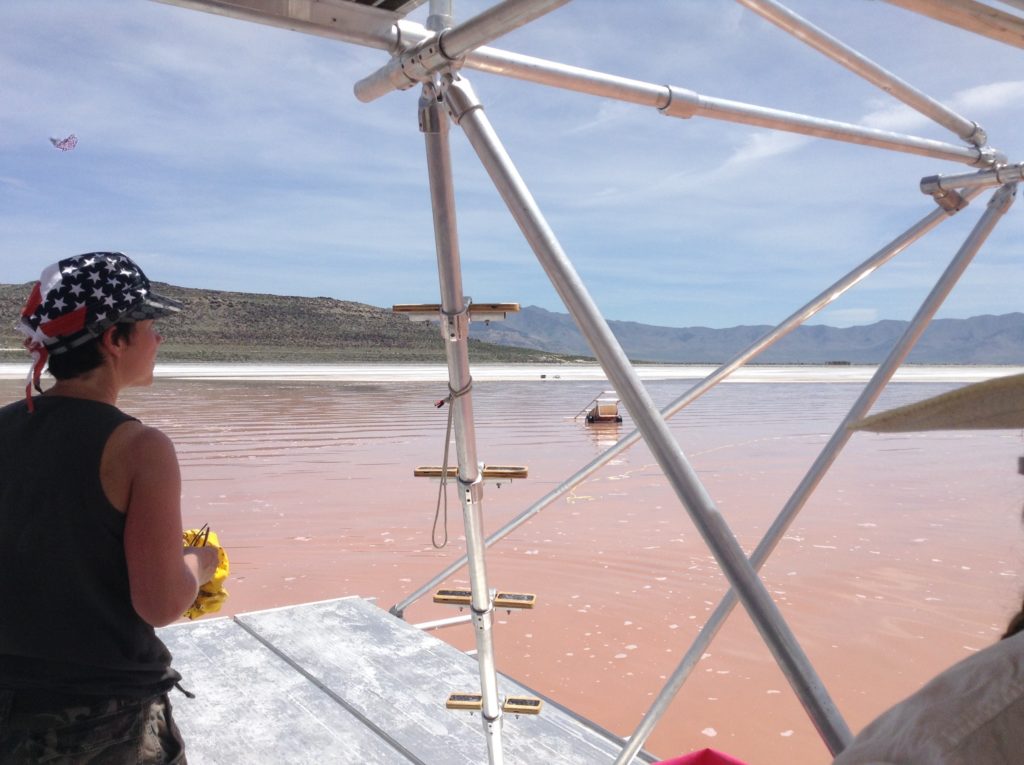
That night we eat buffalo steak, grilled pineapple, and fried polenta. Ingrid, who believes in eating well while camping, is chief chef. As she cooks, she admires a snowcapped mountain in the distance. “It’s like Mount Fuji,” she says. “Those are Japanese print colors.” Every minute the hue of the wide sky shifts: salmon, coral, tangerine, aquamarine, ink.
Deborah, the filmmaker, squats in the dust with a new video camera she’s trying out, capturing the circumvolutions of a pretty snake that has slithered into camp.
Marie, the tide artist, shows us the long, cloudy salt crystals she has been collecting out on the flats. Raised to the light, they hold the pink and blue hues of the lake and sky and look magical, unreal. “If you look carefully, you’ll see a unicorn in there,” she jokes.
Finally it’s dark. There are too many clouds tonight to see the Milky Way, that paramount spiral, but a few stray stars wink in the gaps, and David points out a constellation or two. The light we see tonight swam off those stellar surfaces long ago, he reminds us. Even the light from our nearest star neighbor, Alpha Centauri, has been traveling for years! Despite their semblance of eternity, any of them might be gone by now, for all we know. Winked out.
It’s dark and getting cold, and we’ve been traveling since five a.m. I look toward our tent, but the birthday mezcal has just begun to circulate. The talk—of art and artists, TV and politics—is getting louder and more passionate.
Suddenly Matt, who knows this place best of any of us, holds up a hand. “Listen,” he says. “That’s a train, crossing the Lucin Cutoff.”
In the vast silence, the low rumble can be felt more than heard. We are so far from anywhere that we have to listen with our bones.
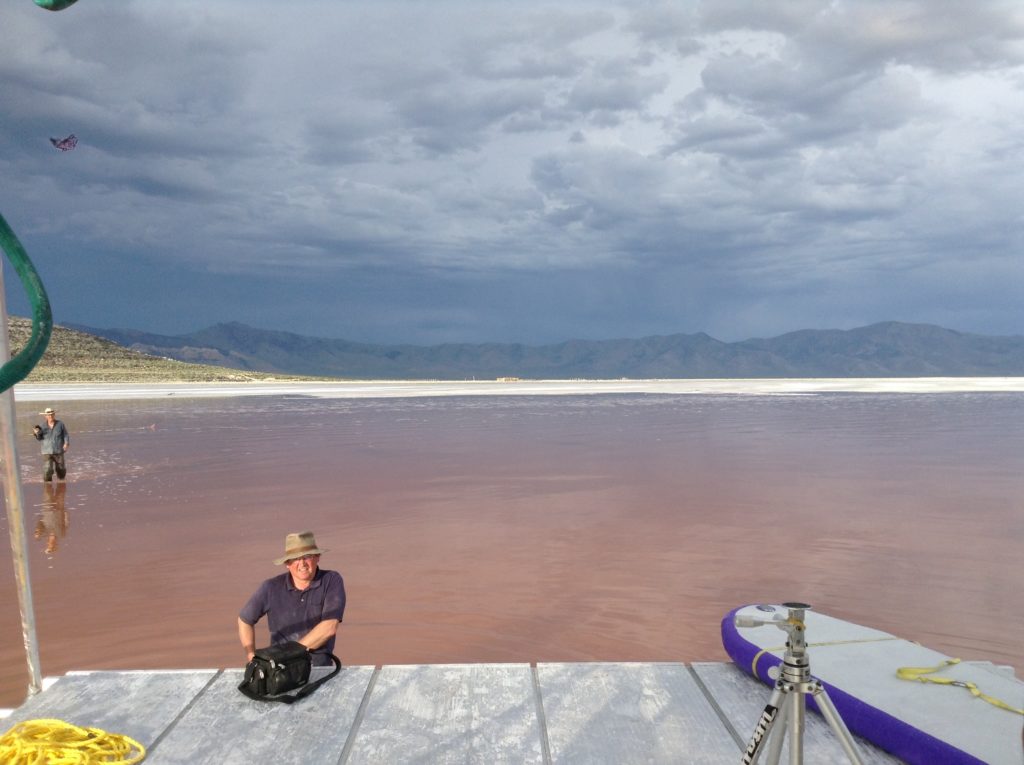
In the morning we head out on the GSLEP again. Chris and Steve want to test a few more things, and besides, what could be pleasanter than a slow putter across the rippling pink lake skin? We pack fresh water, limes, popcorn, dried apricots. Dried salt glints on the aluminum deck as Marie, in a hat spangled with white stars, poles the Platform out from its anchorage. Chris and Steve fiddle with the motor. Deborah has plans to try out a surfboard. Ingrid, who swims every morning before work, is eyeing the briny soup.
Marie is talking to David about tidal rivers, which run in different directions at different times. The Indians of Manhattan, she explains, were master navigators because of their intimate knowledge of the tides. I keep thinking I’ll join this conversation in a minute, but my notebook is open in my lap and I’m scribbling—colors, sounds, scraps of conversations.
“Tides were important for the evolution of life,” David tells Marie. “They helped concentrate the salt that protonucleic acid fragments needed to join up. That’s one theory anyway.” He says he likes the Great Salt Lake because its liminal space—the meandering zone—is so big. “The sky is a liminal space too,” he says. “You can think of it as a meandering zone between the Earth and space.”
A sound drifts down from above. A line of pelicans is soaring through that meandering zone of sky, wings susurrating the air. “A necklace of pelicans!” Ingrid says. Their conversational squawking is a strangely reassuring sound, like the creaking of boats anchored in a harbor at night. Then, as though someone has flicked one end of the necklace, the line of white birds ripples against the sky. A wavering shadow crosses the sunstruck deck. On their way from one marshy feeding ground to another, the travelers must cross this watery desert without stopping. “If their feathers touch the water, they can’t fly anymore and they die,” Chris tells us. Which explains why so many mute, bleached beaks lie enshrouded in the flats.
Marie brings up some books she’s read. She likes science fiction, and why not? With her tide-propelled boats, she has found a way of bringing science and art together herself—of yoking them as in a marriage—which is what the GSLEP hopes to do too. I think of my literal marriage—writer and astronomer yoked together—the quiet life David and I have made. The small garden with its hammock and bright red bee balm. The flagstone patio we pieced together ourselves. The children, made quite literally from our two bodies, then grown like melons from specks of protoplasm to people inside of mine. I shut my notebook and look up, past the aluminum poles and the solar panels, to where the blue air is bestrewn with long strands of cloud like pale hair in need of brushing.
In the midday heat, the mood on the boat turns lazy. Analog electronica floats up from the speakers into the abrasive air, while the water grows darker. At the lake’s edge, a white line of salt is visible, then a wider line of tan sand, then the green mountains. Deborah takes the surfboard out onto the lake. With otherworldly balance, she puts her head down and slowly raises her legs, lifting herself into a headstand. Ingrid jumps in for a dip, but the water is so salty she can barely swim, just bobs along on the surface like a rubber duck, laughing and splashing.
“What time is it?” someone asks, and I look down, but I have left my watch back on shore.
“You can see time written on the mountains,” Marie says, pointing to the brown and taupe layers of rock ascending out of the green slopes, each stratum marking a geologic era.
The signs of spent time lie around us like bones.
At dusk, back on land, David and I head over to Spiral Jetty. We’re leaving early in the morning, and somehow we haven’t even been down here yet. We had thought the trip would be more focused on the artwork, but—as Ingrid explained this morning, watching with a tinge of pity as tourists walked the spiral then got back into their cars—“What we’re doing is of the Jetty.” Matt agreed. The artwork acts as a kind of portal, he said, enabling one to see the whole landscape as art. Boundaries are dissolving, that much is clear. The liminal zone is oozing outward, and what we thought was solid ground slips and yields under our feet.
As the others begin preparing dinner, David and I scramble down to where Spiral Jetty begins. Smithson said this work was inspired by his vision of the Great Salt Lake flats as “an immobile cyclone … a dormant earthquake … a spinning sensation without movement.” He was fond of paradoxes, and of oracular pronouncements.
The long drought has beached the jetty on the dry sand of the lake bed. A straightaway juts out, then curls around, winding inward. There are mosquitos, and it’s getting dark. Stepping across the sandy gaps, David cuts straight toward the center. But I keep to the unscrolling path, picking my way from stone to stone, following the curve. Joining him at last at the heart of the frozen cyclone, I wait—for something to happen. To feel something. The stillness at the core of the universe, perhaps. A oneness, my helixing DNA vibrating to the same frequency as the coiled galaxy. Evening gathers around us. Mosquitos siphon off part of my primordial sea to nourish their young. Moments rise up one after another, then drift away into the darkness.
Rachel Pastan’s most recent novel, Alena, was named an Editors’ Choice in The New York Times Book Review. She is also the author of two other novels, Lady of the Snakes and This Side of Married. She edited Seven Writers, a chapbook of fiction, nonfiction, and poetry inspired by exhibitions at the Institute of Contemporary Art at the University of Pennsylvania, where she served as editor-at-large for several years. She teaches at the Bennington Writing Seminars and Swarthmore College.
